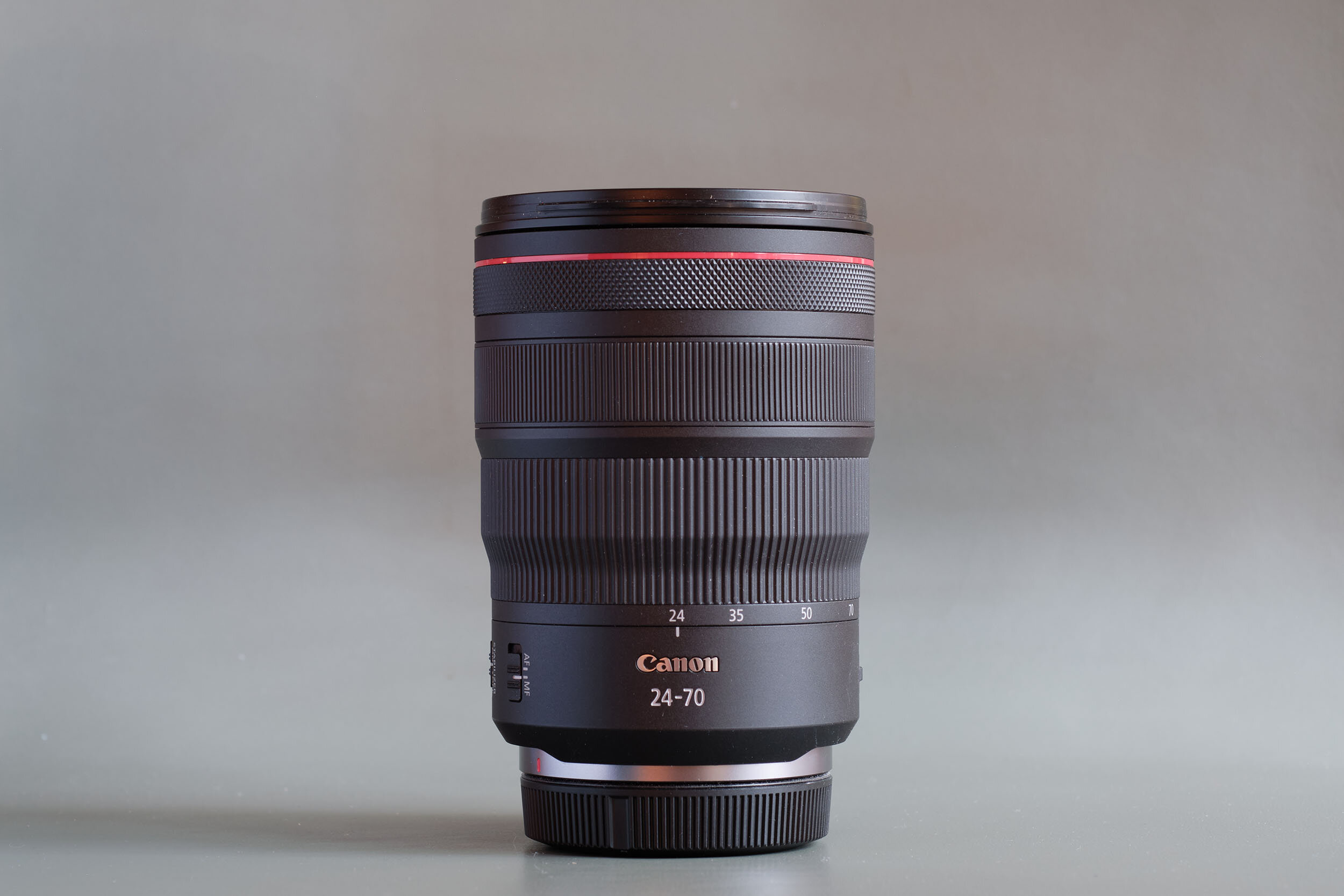Canon RF 24-70mm f/2.8L IS Review

The Canon RF 24-70mm f/2.8L IS
A Fujifilm Photographer’s Quick Look At the Canon RF 24-70mm f/2.8L IS
When I reviewed the Canon EOS R5 last week I tried it with two lenses, the RF 24-70mm f/2.8L IS and RF 70-200mm f/2.8L IS.
I had already tried several other new RF lenses when I took a quick look at the EOS R6 last year and I am always keen on trying new and different gear, even it may not always fall into a category I usually shop in.
Ideally, I would have loved to test some of the smaller RF lenses as I made my departure from lugging around big Canon lenses about six years ago.
The Canon RF 24-70mm f/2.8L IS mounted on a Canon EOS R5
Although I shot Canon DSLRs for a number of years the Canon EF 24-70mm f/2.8 Mark II never found its way into my bag. I was tempted on a few occasions as I did shoot events, weddings, and corporate gigs where a 24-70mm lens undeniably would have made my life easier.
CPS Canada did lend me the EF 24-70mm f/2.8L Mark II and I had it for about a week for my daughter’s high school graduation. I was quite impressed with it at the time.
English Bay Beach, Vancouver, Canon EOS R5, RF 24-70mm f/2.8L IS @ f/5, 36 mm
Canon RF 24-70mm f/2.8L IS - Handling, Specs, and Build Quality
I am puzzled that Canon RF lenses have grown in size and weight compared to their predecessors in the DSLR world. With the move to mirrorless cameras shrunk but lenses grew, what gives?
The RF 24-70mm f/2.8L IS weighs 1.98 lb, 900 g, with a whopping 82mm filter diameter and dimensions of 3.48 x 4.95" / 88.5 x 125.7 mm. The balance on the EOS R5 is okay but mostly because there is so much volume to hold onto and it is front-heavy.
The lens formula sports 3 aspherical elements, 3 UD elements, and 9 rounded diaphragm blades. Further to this, the RF 24-70mm has a five-stop optical image stabilizer and a customizable control ring that can be configured to a number of functions, ie. aperture or exposure compensation.
The Canon RF 24-70mm f/2.8L IS currently retails for $2,299.00.
Barnston Island, Canon EOS R5, RF 24-70mm f/2.8L IS @ f/3.5, 70 mm
The Canon RF 24-70mm f/2.8L IS in Action
I took the RF 24-70mm f/2.8L IS on a cycling trip around Barnston Island and along the trail from Derby Reach Regional Park to Fort Langley and back.
While the focal length range of 24-70mm provided me with great flexibility it was a far cry from how I usually travel with a lighter camera with one, and sometimes two smaller Fujifilm primes. The Canon EOS R5 and RF 24-70mm f/2.8L IS became cumbersome to lug around and while I did manage to cycle with the camera and lens it was a strain that I did not enjoy.
For the new RF lenses, you have to line the lens cap up properly in just one correct position before you can attach it to the lens. I am not sure who figured this would be a great idea. It makes it unnecessarily difficult to switch lenses quickly when you are in the field. End of rant.
Barnston Island, Vancouver, Canon EOS R5, RF 24-70mm f/2.8L IS @ f/4.5, 29 mm
I took the RF 24-70mm through the streets of Vancouver for some street photography and I could pretty much repeat what I said above in regard to weight, size, and enjoyment factor.
The RF 24-70mm f/2.8L IS is obtrusively big for this purpose and while it may produce great image quality I just didn’t find it to be the right application for this lens.
Burrard Street, Vancouver, Canon EOS R5, RF 24-70mm f/2.8L IS @ f/5.6, 70 mm
Canon RF 24-70mm f/2.8L IS - Image Quality
The RF 24-70mm f/2.8L IS is probably as good as it gets when it comes to image quality in this segment. I didn’t see any major flaws but nor did I find reasons to really go looking.
The colors are pleasing and you could say same the same about the bokeh. And I cannot complain about sharpness either but then again I would expect it to check all boxes being a $2,299.00 lens.
With that said I still feel I come away a bit short with the 24-70 and it is probably because I have chosen to shoot prime lenses primarily. That goes for my time with Canon as well as Fujifilm.
While I feel the image quality is sufficiently good from the RF 24-70mm I also think it lacks somewhat in character and that last bit of razor-sharp pop and bokeh you may get from a prime.
Fort to Fort Trail, Fort Langley, Canon EOS R5, RF 24-70mm f/2.8L IS @ f/4.5, 54 mm
Conclusion
The RF 24-70mm f/2.8L IS is a workhorse lens designed for ultimate versatility in a very useful focal length range and with a fast constant f-stop throughout the zoom range. I am sure Canon photographers subscribing to the R system have no qualms about shelling out the rather steep price of entry.
If you have read the above paragraphs and didn’t skip to the conclusion it should, however, be crystal clear that this lens isn’t for me and that is okay. I have become accustomed to carrying smaller primes that are easier on the back for travel or more inconspicuous for street photography.
I do understand the appeal of zoom lenses such as the RF 24-70mm f/2.8L IS but if I was entering the EOS R system I would be eying out some of the new prime lenses as I do find they may offer an extra sprinkle of mojo that can set your work apart.
Burrard Street, Vancouver, Canon EOS R5, RF 24-70mm f/2.8L IS @ f/5.6, 70 mm
A few weeks ago I tested the Fujifilm XF 16-55mm f/2.8 R LM WR on the X-Pro3 and despite the lack of image stabilization, I would say I enjoyed the experience more so than the EOS R5 and RF 24-70mm f/2.8L IS combination. It quite simply comes down to the bulk/size/weight issue while also keeping the significant price jump to the Canon combination in the back of my mind.
To see more sample images from the RF 24-70mm f/2.8L IS please see my review of the Canon EOS R5 here:
Pros
Overall image quality
Built-in image stabilization
Fantastic build quality and feel
Cons
Size and weight
Price
Please see more sample images below.
Price / Availability
Thank you for reading my review. If you are planning a purchase and would like to support us, you can do so, at no additional cost, by using the affiliate link below. A small commission goes to us and helps us keep the wheels turning at 5050 Travelog.
Check the current price at B&H Photo
Canon RF 24-70mm f/2.8L IS - B&H Photo
Thank you for being supportive.
Canon RF 24-70mm f/2.8L IS - Sample Images
Please see more sample images below. The photos are processed from uncompressed RAW files in Lightroom.
Please click to view larger images.
Granville Island, Vancouver, Canon EOS R5, RF 24-70mm f/2.8L IS @ f/5.6, 70 mm
Granville Island, Vancouver, Canon EOS R5, RF 24-70mm f/2.8L IS @ f/5.6, 33 mm
Vanier Park, Vancouver, Canon EOS R5, RF 24-70mm f/2.8L IS @ f/4, 46 mm
English Bay, Vancouver, Canon EOS R5, RF 24-70mm f/2.8L IS @ f/5, 50 mm
English Bay, Vancouver, Canon EOS R5, RF 24-70mm f/2.8L IS @ f/5, 41 mm
Barnston Island, Vancouver, Canon EOS R5, RF 24-70mm f/2.8L IS @ f/4, 58 mm
Barnston Island, Vancouver, Canon EOS R5, RF 24-70mm f/2.8L IS @ f/3.2, 57 mm
Golden Ears Way, Canon EOS R5, RF 24-70mm f/2.8L IS @ f/5.6, 24 mm
Barnston Island, Vancouver, Canon EOS R5, RF 24-70mm f/2.8L IS @ f/3.5, 70 mm
Barnston Island, Vancouver, Canon EOS R5, RF 24-70mm f/2.8L IS @ f/3.5, 70 mm
Golden Ears Way, Canon EOS R5, RF 24-70mm f/2.8L IS @ f/3.5, 70 mm
Barnston Island, Vancouver, Canon EOS R5, RF 24-70mm f/2.8L IS @ f/4.5, 35 mm
Fort to Fort Trial, Vancouver, Canon EOS R5, RF 24-70mm f/2.8L IS @ f/3.5, 62 mm
Fort to Fort Trial, Canon EOS R5, RF 24-70mm f/2.8L IS @ f/4.5, 24 mm
Fort Langley Community Hall, Canon EOS R5, RF 24-70mm f/2.8L IS @ f/5.6, 38 mm
Coal Harbour, Vancouver, Canon EOS R5, RF 24-70mm f/2.8L IS @ f/6.3, 32 mm
Burrard Street, Vancouver, Canon EOS R5, RF 24-70mm f/2.8L IS @ f/8, 35 mm
